I . Survey
(i) Geographical position
S i c h u a n p r o v i n c e i s l o c a t e d i n southwestern China and upper reach of Yangtze
River which resides between 97°21’-108°31’east longitude and 26°03’- 34°19’n o r t h
latitude, the province is highly accessible for its vicinity to Qinghai province, Gansu province and
Shaanxi province at north, to Chongqing municipality at east, to Yunnan province andGuizhou Province at south and to Tibetan autonomous region at west. It spans 1,075km from east to west and 921km from south to north including 18 prefecturelevel cities and 3 ethnic autonomous
prefectures. The provincial government administers 181 counties (cities and districts) including 43
city-administered districts,14 county-level cities, 120 counties and 4 autonomous counties. The
area of Sichuan province is the fifth largest one among all Chinese provinces covering 485
thousand square km. Chengdu, the capital of Sichuan province, is the western hub for business
and trade, science & technology, finance, transportation and communication in China, It is also an
attractive city for establishing development zone. Sichuan province features the mountainous areas
and plateaus supplemented with plain, hill, mountainous areas and plateaus. Generally speaking,
Sichuan province can be divided into two parts geographically: the eastern part features basin and
western part features mountainous areas and plateaus.
(ii) Climatic Characters Sichuan province resides in subtropical zone with mild and humid
climate, the average temperature is above 16 ℃ on yearly base, the annual precipitation is 1,000 to 1,400 mm. Because of different geographical features, the climate of basin is totally different from that of mountainous areas and plateaus at west. The basin part of Sichuan province bears mild subtropical monsoon climate which has warm winter, dry spring, hot summer and rainy autumn, while the mountainous a r e a s a n d p l a t e a u s a t northwest enjoys long lasting winter, absence of summer, mixing climate of spring and autumn, large temperature fluctuation between day and night, intense and long lasting sunshine during day time.
(iii) Population and Ethnic groups
The total population of Sichuan province was 87.5 million in 2005, the third largest figure among Chinese provinces, 27 million out of it are the urban population, accounting for 33% of permanent population, 54 million out of it are the rural population, accounting for 67% of permanent population.
Many ethnic groups inhabit in Sichuan province, except for Han nationality, there are Yi, Tibetan, Qiang, Tujia, Miao, Hui, Manchu, Zhuang, Bai, Dai, Lisu, Mongol, Naxi, Bouyei, Dong and Hani nationalities etc in Sichuan province, It also has the largest living compact for Yi nationality and the only living compact for Qiang nationality across the country, the Tibetan population in living compact here is only next to that in Tibet Autonomous Region. The ethnic autonomous region covers 304 thousand square kms of land, accounting for 62.7% of total area of the province.
Transportation
Airport, Aviation and Flight Chengdu Shuangliu International Airport is the fifth in China, and there are 9 smaller airports for flights within the province. Chengdu Shuangliu International Airport handles 30 international flights and more than 200 domestic fl ights now. Airplanes taking off from the airport can directly reach Singapore, Hong Kong, Macao, Seoul, Tokyo, Penang, Fukuoka, Katmandu, Bangkok, Kuala Lumpur, Phuket, Pairs, New York and San Francisco etc.
Road
The total mileage of road has reached 115 thousand kms at the end of 2005, including 12 thousand kms of first-class and second-class road. The total mileage of expressway in the province has reached 1,759km, ranking the fi rst in West China and sixth across the country.
Railroad
The total length of railroad open to traffi c reached 3,009 kms at the end of 2005, all major lines are of electrization
Finance and Insurance
By the end of 2005 the total deposit balance of all social fi nancial bodies reached 990.53 billion Yuan, all kinds of balance of loans reached 674.3 billion Yuan. The total volume of insurance premium reached 18.94 billion Yuan, and 4.61 billion Yuan were used for all kinds of indemnity and balance payment.
Telecommunication
By the end of 2005, the subscribers of fixed phone reached 15.7736 million, and 38% of the population have access to phone. The total number of subscriber of mobile phone reached 16.8973 million.
Internet
The number of registered users reached 3.16 million by the end of 2005.
(v) Foreign Related Activities
Twin provinces, prefectures and cities Sichuan province has established stable economic and trade relationship with more than 100 countries and regions, and paired with 48 provinces, prefectures and cities, including Washington State of the United States, Nordrhein-Westfalen of Germany and Hiroshima-ken of Japan.
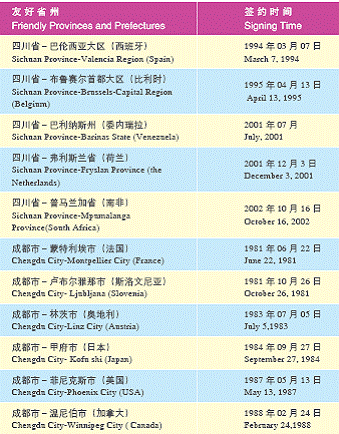
International exhibitions
There are grand commercial gatherings every year in Sichuan province, such as West China International Economic & Trade Fair, China Spring Season Foodstuff and Beverage Trade Fair, China Western Cross-straits Economic and Scientific and Technical Corporation and Exchange Fair and Medical Products Exhibition and International Meeting for Modernization of Chinese Traditional Medicine etc.
The Western China International Economic & Trade Fair It is a statelevel large scale fair which integrates product exhibition, project negotiation and commercial seminar. It is held in Chengdu from May 25th to 28th each year. Till now we have seen success of seven years of The Western China International Economic & Trade Fair. They have been characterized as being professional, market-oriented, internationalized in a high degree. It is the pivot of information flow, cash flow, logistics, personnel flow, and is strong in commercial attractiveness. There are manufacturers, investors, dealers, and suppliers from 31 provinces, municipalities and autonomous regions in China taking part in this fair. This fair has also seen the presence of state leaders, foreign political celebrities, directors from international economic organizations, CEOs from World Top 500, Chamber of Commerce leaders, and foreign diplomats in China, etc
(vi) Brief Introduction of Higher Education and S&T Research in Sichuan Province
Sichuan province enjoys strong S&T research capacity stemming from advanced equipment and large pool of talents in this regard; it has become another S&T research base after Beijing and Shanghai. There are more than 1 million technicians working in 15 state level key laboratories, 60 provincial level key laboratories and 9 state level engineering technology research center. There are 57 academicians of Chinese Academy of Science and Chinese Academy of Engineering.
The development of education has been in full swing. By 2005, there were 72 Higher Learning Institutes with total student population of 775 thousand including 49 thousand graduate students, and 111 middle class professional schools with student population of 227 thousand, and 4,995 middle schools with student population of 4.855 million, and 19 thousand elementary schools with 7.145 million pupils.
(vii)Tourism
Scenic Spots and Cultural Relics
There is a saying that the mountains and rivers in Sichuan province are the most beautiful ones in the world. Mountains and rivers here are full of vigor and reflects the divine spirits. The province is also famous as the“ hometown of panda”. Sichuan province has the largest number of places which are listed in world natural and cultural heritage and largest number of state-level scenic spots, out of which, Jiuzhaigou Scenic and Historic Area, Huanglong Scenic and Historic Area, Leshan Giant Buddha, Mt Emei and Wolong Natural Reserve have been included in《World Natural and Cultural Heritage List》and MAB Network by UNESO; Nine scenic spots, including Dujiangyan Ancient Water Conservancy Project, Mt Qingcheng, Jianmen Gate, Mt Gongga, Bamboo Sea in southern Sichuan, Mt Four Girls, Mt West-Summit and other two places are the state level scenic spots. Besides, there are 11 national forest parks, 40 natural reserves and 44 provincial scenic spots including mountainous areas, gorges, basins, plains, rivers and lakes at various sizes, hotsprings, waterfalls, Karst Areas and Danxia landforms, so Sichuan province has been crowned with the name of“ Province of Geographic Beauty”.
Sichuan province has long history and brilliant civilization which have extended more than 4,500 years since the time of Cancong and Yufu. This place is blessed with abundant natural resources and suitable dry and flood periods of rivers, so it has been known as the“ Land of Abundance”. There are 7 national famous historical and cultural cities, 40 cultural relics under the national protection and 24 provincial famous historical and cultural cities (counties) in the province. There are also all kinds of tourist attractions including ancient water conservancy project, residents of ancient towns, former residence of celebrities, Buddhist and Taoist Temples, stone sculptured murals, museum for modern art, pre-historical relics and modern buildings. The south Silk Road extends to south through the province; heroes of The Three Kingdoms left us with numerous legends; the world famous Long March of the Red Army added glory to our past by fi nishing the most arduous section of the March in western Sichuan province. Furthermore, there are many ethnic minorities living in this beautiful place, including Tibetan, Yi, Qiang and Naxi minorities. They have many different ethnic festivals such as Lantern Festival, Flower Fair, Mountain Strolling Fair, Racing Day and Torch Festival; the Sichuan cuisines and drinks are famous around the world and attract tourists both from home and abroad.
Local Products
Wi t h l a r g e a r e a s , l o n g h i s t o r y , abundant cultural and natural resources, Sichuan province has unique conditions for development of tourist products. Many local traditional products have been famous for a long time for their refined craftsmanship: the Shu Brocade which is one of the most famous Brocades in China, Shu Embroidery which is one of the most famous Embroideries in China, lacquer wares, woven bamboo wares and silver thread etc are the representatives of Sichuan traditional tourist products.
Delicacies
As one of the four major Chinese cuisines, Sichuan cuisine features spicy dish and is famous both at home and abroad for its special cooking methods and strong local flavor.All this characters make Sichuan cuisine a shining pearl in Chinese food culture and to be known as the cuisine of “every dishes has its own character and taste”. The representative dishes include Diced Chicken with Chili Peanuts, The Braised Fish with Chili Sauce, Twicecooked Pork, Mapo Tofu, Couple's Slices of Lung, Tea Smoked Duck, Stewed Thin Beef Slices, Fish-fl avored Pork Threads and Beef Boiled in Spicy Sauce etc.
(viii) Chengdu, A City Once You Come, Never Wish to Leave
Chengdu, the capital of Sichuan province, has been the important city in southeastern since the ancient time: it was the capital of Kingdom of Shu Han during the Three Kingdoms period and the capital of Former Shu and Later Shu, so it has many cultural relics and was named as the national historical and cultural city by state council in 1982. Chengdu is located in the center place of Chengdu Plain and covers 12,390 square km.
City of Glamour
Chengdu is a beautiful and modernized metropolis, 35.7% of main urban areas has been greened up. After the implementation of Funan River construction and comprehensive renovation project which took 5 years and involved 2.7 billions Yuan, Funan River has become a model of environmental protection work in Chengdu.UN granted Chengdu with Habitat Scroll of Honor A w a r d , L o c a l I n n o v a t i o n A w a r d and Dubai International Award for Best Practice to Improve the Living Environment. The 2004 Award for National Model City on Human Settlements was granted to Sha River comprehensive renovation project, the upgrading project for flood prevention facilities in Jintang County and ecological campus construction project of Southwest University for Nationalities. Chengdu is the famous tourist destination with 172 historical sites, among which some are highly known around the world. The most representative historical sites include Wuhou Temple, Dufu Thatched Cottage, The Royal Tomb of Wang Jian, Dujiangyan ancient water conservancy project, Erwang Temple, Mt Qingcheng. There are 19 historical sites under national and provincial protection and the only Base of Giant Panda Breeding in the world. Chengdu resides at the converging point of country tourist routes circle and Sichuan tourist routes circle on which the ancient Shu Road of Jianmen gate, Jiuzhaigou Scenic and Historic Area, Mt Emei and Three Gorges are the tourist destinations, it is also the main way to go to Tibet on land, so Chengdu enjoys obvious advantage for tourist development.
An open city
The people’s government of Chengdu municipality has been laying great importance to the establishment of good investment environment; a multi-layer and comprehensive opening up pattern has come into being under those efforts. The export oriented enterprises in Chengdu are actively exploring international market to keep the rapid growth of export volume, the trade of processing industry and export of machine and electronic products have registered strong increase. Chengdu has constantly expanded the export volume to many countries and regions including United States, Europe Union, Japan, southeast Asian, Africa and Latin America etc. Many export oriented products, including silk and satin, textile, measuring and cutting tools, household appliance, meats and meat-related foodstuff, agricultural and side-line products, chemical raw materials and steels, are enjoying reputation in international market.
A City of Development
As the transportation hub of southwestern China, Chnegdu has the largest airport in this area, that is Chengdu Shuangliu International Airport, Chengdu is also the converging point of Baoji-Chengdu railway, Chengdu-Chongqing railway, Chengdu- Kunming railway and Chegnda railway, the trunks of 6 national highways, including that of No 317 national highway, cross Chengdu; the construction of 7 highways within Sichuan province have been fi nished and all of them have been opened to traffi c; the cyclic and radioactive 3-D urban transportation network has come into being after completion of construction of the major urban trunk including First Ring Road, Second Ring Road, Third Ring Road and the expressway circling downtown area etc. The total number of fixed phone subscribers is 3.838 millions and 6.581 millions of mobile phones. Chengdu center of Sichuan Internet Network has been in operation, which smoothes the communication in downtown area. The reform of power generation facilities in urban and rural areas has been basically finished, which enables enough power supply in urban and rural areas, with the annual power supply to downtown area of 14.52 billion kwh; the downtown areas can be supplied with 1.971 million tons of water every day; the capacity of supplying natural gas and liquidized oil gas has increased, with 2.6 billion square meters of natural gas extracted and supplied. The supply of water, power and natural gas to downtown and suburban areas (including surrounding districts and cities) is abundant to meet the people’s need for living, production and construction. With all the aforementioned achievements, an ideal municipal utilities structure with comprehensive functions has come into being
(i) GDP
The GDP of Sichuan province in 2005 reached 738.511 billion Yuan, per capita GDP achieved 9,060 Yuan. The volume of primary industry, secondary industry and tertiary industry accounted for 149.57 billion Yuan, 305.27 billion Yuan and 283.67 billion Yuan respectively. The contribution rates of those three industries to economic development were 9.1%, 57.5% and 33.4% respectively.
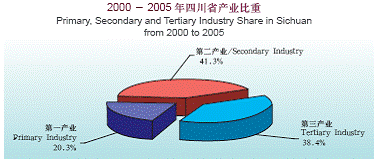
(ii) Resources, Industries and Agriculture
Natural resources
Water resources are the most abundant in China with the potential of generating 110 million kw, the biggest capacity among all provinces in China. Sichuan is also the base for hydroelectric power generation and for implementing the strategy of transmitting electricity from western areas to eastern areas. Ertan hydroelectric station has the installed power- generating capacity of 3.3 million kw, the greatest capacity among that of all hydroelectric stations which have been put into use since 20 century, and also the greatest capacity among that of all hydroelectric stations which are currently being used in Asia. Sichuan has almost all kinds of mineral resources: 130 kinds of minerals have already been found, the volume of proved reserve of 89 kinds of minerals meet requirement of industrialized exploitation, out of those 89 kinds of minerals, the reserve volume of 11 minerals including vanadium, titanium, lithium, silver, sulfurous iron ore, natural gas etc ranks the first in China (the reserve volume of vanadium and titanium ranks the first around the world). Sichuan owns the varieties of vegetation and the number of higher plant accounts for around one third of country’s total, there are many rare varieties of trees including the ones known as the “living Fossil”, such as metasequoia, Cathaya argyrophylla and redwood; The number of pines and China fi rs ranks the fi rst in China.
Industry
In 2005, the added value of industries across province was 251.258 billion Yuan and their contribution rate to economic growth was 53.0%. Sichuan province has large industrial scale and comprehensive occupations: the output of power, natural gas, steel, cement, flat glass, fertilizer, pesticide, thread, raw salt, beer and color TV set etc rank the first among a l l w e s t e r n p r o v i n c e s ; t h e mechanism industry, electronic industry, metallurgical industry, chemical industry, construction industry, foodstuff industry, medicine industry and leather industry etc in Sichuan province occupy an important position in China; Many key enterprises in Sichuan are famous around China, such as Changhong Group CO LTD, Wuliangye Group, Pan Steel Group Co and Southeastern China Gas Field Company etc.
Agriculture
In 2005, the annual grain output of Sichuan province achieved 34.092 million tons, ranking the third across the country; oil output reached 2.323 million tons, ranking the fifth across the country; 87.643 million hogs were bred and 6.524 million tons of pork were produced, ranking the fi rst across the country; the total output of pork, beef and mutton reached 7.397 million tons, ranking the second across the country; the output of meat related foodstuff reached 9.492 million tons; the trees were planted on 265 thousand hectares of chunk of land, 73 thousand hectares out of which was formerly cultivated lands, this efforts makes 29% of total areas of province are now covered by forests.
(iii) Development of Commerce
Import and Export
The total volume of import and export combined in 2005 reached 7.9 billion USD, including 4.7 billion USD from export and 3.2 billion USD from import. The export volume of general trade was 3.81 billion USD, that of processing trade reached 510 million USD. The export volume of SOEs, collective and private enterprises were 2.32 billion USD, 420 million USD and 1.28 billion USD respectively. Among all exported goods, the export volume of agricultural products, mechanical & electronical products and Hi & New tech products were 440 million USD, 1.57 billion USD and 590 million USD respectively.

Utilization of Foreign Investment
In year 2005, 1.1 billion USD of investment were actually utilized in Sichuan p r o v i n c e , w i t h t h e i n c r e a s e o f 1 1 % comparing to the same period of last year. Accumulatively, the people’s government of Sichuan province approved 7,317 enterprises with foreign investment to run business there and 121 out of the world 500 top enterprises have had their investment or offi ces established in Sichuan province.
Foreign Cooperation
245 foreign related contracted projects and labor corporation contracts were signed in 2005 with the total value of 1.41 billion USD, 600 million USD of turnover were made from these contracts and projects; 17,549 people were sent to other countries to provide labor services. There were 13 new enterprises with foreign investment established in Sichuan province, the Chinese portion of total investment in these enterprises were 14.255 million USD.
Technology Introduction
In 2005, 245 technical projects h a d b e e n i n t r o d u c e d w i t h 2 8 7 million USD as the total contractual value, including 172 million USD for technical introduction and 116 million USD for related equipments.
Circulation of Commodities
The total volume of retail sale were 298.14 billion Yuan in 2005, including 144.69 billion Yuan from urban markets, 153.45 billion Yuan from markets at no higher than county level. The trade volume of retail and wholesale industries were 233.76 billion Yuan and that from catering trade were 54.56 billion Yuan.

(i)Policy and Administrative Rules
Catalogue of Related Laws
Foreign Trade Law of the People’s Republic of China
Customs Law of the People’s Republic of China
Law of the People’s Republic of China on Import and Export Commodity Inspection
Law of the People’s Republic of China on Chinese-Foreign Equity Joint Ventures
Law of the People’s Republic of China on Chinese-Foreign Contractual Joint Ventures
Law of the People’s Republic of China on Foreign-Capital Enterprises
Company Law of the People’s Republic of China
Law of the People’s Republic of China on the Entry and Exit Animal and Plant Quarantine
Law of the People’s Republic of China on Control of the Entry and Exit of Aliens
Law of the People’s Republic of China on the Control of the Exit and Entry of Citizens
Securities Law of the People’s Republic of China
Income Tax Law of the People’s Republic of China for Enterprises with Foreign Investment and Foreign Enterprises
Individual Income Tax Law of the People’s Republic of China
Law of the People’s Republic of China on the Administration of Tax Collection
Environmental Protection Law of the People’s Republic of China
Law of the People’s Republic of China on Evaluation of Environmental Effects
Law of the People’s Republic of China on Promotion of Cleaner Production
Law of the People’s Republic of China on Prevention and Control of Desertifi cation
Marine Environment Protection Law of the People’s Republic of China
Law of the People’s Republic of China on the Prevention and Control of Atmospheric
Pollution
Law of the People’s Republic of China on Prevention and Control of Environmental Pollution by Solid Waste
Law of the People’s Republic of China on Prevention and Control of Water Pollution
Law of the People’s Republic of China on Prevention and Control of Environmental Noise Pollution
Law of the People’s Republic of China on Prevention and Control of Radioactive Pollution
Frontier Health and Quarantine Law of the People’s Republic of China
Labour Law of the People’s Republic of China
T r a d e U n i o n L a w o f t h e P e o p l e’s Republic of China
Searching Website for the Related Laws
1 . S e a r c h i n g S y s t e m o f L a w s a n d Regulations of China (website of National People’s Congress of China)
http://law.npc.gov.cn:87/home/begin1.cbs
2. China Legislative Information Network System
http://www.chinalaw.gov.cn/jsp/jalor/index.jsp
3. Ministry of Commerce
http://www.mofcom.gov.cn
the above-mentioned websites are for reference only.
(ii) Catalog of Advantageous Industries of Sichuan
Province for Foreign Investment
The development of follow-up industries of national key ecological projects such as returning the formerly cultivated land to forest and grassland and protecting naturally formed forests etc
Development and application of water saving irrigation technology The intensive processing of rare earth and production of related applicable products
Construction of high yielding and high quality silkworm-eaten mulberry growing base and silk products processing
Ramie fabric and related goods production
Development and production of animal and plant recourses that can be used as medicine (excludes those which have been under the national protection) Production and development of the downstream chemical products of natural gas
Production of electrician membrane
Construction and operation of natural gas, heat supply, water supply and drainage network in urban areas(controlled by chinese side in large and middle-sized cities)
The development of scenic areas (spots) and construction, protection and operation of related supporting facilities
Highway passenger transportation
(iii) Procedure for Enterprise Establishment & Required Documents

Note:
(1) Infrastructure projects shall be approved by development and reform commission, and technological transformation projects shall be approved by economic commission(commercial department).According to the Catalogue for the Guidance of Foreign Investment Industries, any encouraged or permitted project with gross investment (including funds raised) of US$ 100 million and above, and any restricted project with gross investment of US$50 million and above shall be examined and verified by relevant provincial authorities according to laws and then shall be submitted to the State Development and Reform Commission for approval. Any encouraged or permitted project with gross investment which ranges from US$ 30 million (inclusive) to US$ 100 million, and any restricted project with gross investment below US$50 million shall be examined and verified by relevant provincial authorities. Any encouraged or permitted project with gross investment below US$ 30 million shall be examined and verified by relevant municipal (prefecture level) authorities. Chengdu municipal authorities are entitled to approve any encouraged or permitted project with gross investment below US$ 100 million.
(2) Project Confirmation Certificate issued by national or provincial tax reduction and exemption authorities shall be required for tax reduction and exemption of foreigninvested enterprises.
(3) Besides certificate-issuing right for exploitation and mining of special mineral varieties such as petroleum, natural gas and radioactive minerals and certificate-issuing right for mining of tungsten, tin, magnesium, rare earth, which shall be subject to firstlevel administration stipulated by laws and regulations, Sichuan Provincial Land and Resources Department also exerts right for approving, registering and issuing certifi cates for foreigner’s investment, exploitation, mining of mineral resources in Sichuan province.
Required Documents for Establishment of Foreign-invested Enterprise
1. Documents to be submitted to Development and Reform Commission
A. Project name, business term, profi le of investor;
B. Project construction scale, main construction contents and products, main technology and process, product target market, planned number of labor;
C. Address of project, demands on resources including land, fresh water, energy, etc., consumption volume of main raw materials;
D. Price of public products or service;
E. Gross investment of project, registered capital, amount contributed by each party, contributing mode and financing scheme, equipment to be imported, amount of equipment.
Documents listed below shall be also attached:
A. Certifi cate of Incorporation (Business License) of Chinese and foreign investors, Business Registration Certificate and the latest financial statements(including balance sheet, profit and loss statement and cash flow statement), credit certificate issued by the deposit bank;
B. Investment intention; projects of capital Increase and acquisition and merger resolution of board of directors of the company with projects of capital Increase and acquisition & merger;
C. Financing intention issued by bank;
D. Environmental Impact Report issued by national or provincial environmental protection departments;
E. Planning for Land Use issued by national or provincial land and resources departments;
F. Confirmation documents issued by competent authorities for projects to be invested in form of the state-owned assets or land use right.
(2) Documents to be submitted to business departments
1) Sino-Foreign Equity Joint Venture, Sino-foreign Cooperative Joint Ventures
A. Application for establishment of joint venture;
B. Feasibility Study Report; Approval from Provincial Development and Reform Commission or Economic Commission;
C. Contract, articles of association (signed by legal representatives of Chinese and foreign investors or authorized persons of the legal representatives);
D. Appointment letter of directors signed by legal representatives of investors;
E. Chinese and foreign investors shall submit business license, incorporation certificate, credit certificate, valid evidences of legal representative.
Documents listed below shall be also attached:
A. Notice for registration approval of enterprise name issued by administration for industry and commerce;
B. A list for equipment to be imported shall be provided (including equipment name, specifi cation, quantity and price), if required;
C. If the state-held enterprises make investment by using the fixed assets, assets evaluation report is required;
D. If any of the above documents is to be signed by the authorized person, an authorization letter (original) of legal representative of investor shall be provided.
2) Foreign-invested enterprises
A. Application concerning establishment of foreign-invested enterprise (signed by legal representative of investor or authorized person);
B. Application concerning establishment of foreign-invested enterprises in China (signed by legal representative of investor or authorized person);
C. Articles of association of foreigninvested enterprise (signed by legal representative of investor or authorized person);
D. Legal evidences and credit certifi cate of investor (bank certificate, deposit certifi cate or bank statement, or audited report for fiscal year from accountant, or title deed of house property, or renewed business license of Taiwan enterprises. No credit certifi cate is required for direct investment by any world famous enterprise).
Documents listed below shall be also attached:
A. Notice for registration approval of enterprise’s name issued by administration of industry and commerce;
B. Director authorization letter signed by each investor if board of directors is required to be established;
C. ID certifi cation of legal representative of investor (e.g. Passport, ID card, etc.);
D. A list for equipment to be imported shall be provided (including equipment name, specifi cation, quantity and price), if required;
E. Two or more foreign investors who will jointly establish foreign-invested enterprise shall provide duplicate of the signed contract for review;
F. If any of the above documents is to be signed by authorized person, authorization letter (original) of legal representative of investor shall be provided.
(3) Documents required by authority of industry and commerce
A. Application for Establishment and Registration of Foreign-invested Enterprise;
B. Approval documents issued by approval authority (one duplicate of reply and approval certificate); joint-stock company limited established in fund-raising manner shall submit approval documents of securities administration departments of the state council;
C. Approval documents for relevant project proposal or feasibility study report;
D . C o n t r a c t s ( n o t r e q u i r e d f o r exclusively foreign-owned enterprise) and articles of association;
E. Name pre-approval Notice of foreign-invested enterprise;
F. Legal business-opening certificate and credit certifi cate of investor;
G. Original of appointment document of legal representative/director/supervisor; duplicated copies of ID cards;
H. Registration/Record Form for Property Right of state-owned assets(only applicable for state-owned enterprises);
I. Certifi cate for use of dwelling house;
J. Cahier of establishment meeting, agreement of sponsor, financial audit report for establishing the company (only applicable for joint-stock company limited);
K. Capital verifi cation certifi cate issued by competent capital verifi cation institution(applicable for joint-stock company limited and fi nancial institutions);
L. Project priority examination and approval documents or certificates, if applicable;
M. Other related documents or certificates.
Foreign Exchange Registration
Applying for foreign exchange registration of foreign-invested enterprises
Before doing this at the Administration of Foreign Exchange, foreign-invested enterprises
should beforehand get permission from authority of commerce and Approval Certificate of Foreign-invested Enterprises and acquire Business License from administrative authority of industry and commerce.
After this is done at the Administration of Foreign Exchange, enterprises will obtain
Certificate of Foreign Currency of Foreigninvested Enterprises.
This certificate shall be shown when the enterprises doing foreign exchange transaction in the Administration of Foreign Currency or banks.
Application Materials
(1) Basic Information Form of Foreigninvested Enterprises marked by seal of applying company and Certifi cate of Foreign Currency Registration for Foreign-invested Enterprises.
(2) The duplicate of business license of legal person of enterprise, non-legal person Sino-foreign contractual joint venture should provide business license (the original or a copy marked with original seal; copy retained).
(3) Permissive files and originals of certifi cates issued by commercial authority.
(4) Permissive files and originals of joint venture or cooperation agreement and constitutions (originals or duplicate copy with original seals shall be checked and the duplicate copy shall be kept for records).
(5) Organization Code Certificate issued by State Quality and Technology Supervision Bureau.
(6) When re-applying for Certificate of Foreign Currency Registration for Foreigninvested Enterprises, an enterprise should publish a loss claim on a national scale newspaper.
Note: Other information can be gained from local foreign currency administrative bodies.
Regulations for employment
In accordance with Labor Law of the People’s Republic of China and Regulations of the People’s Republic of China on Labor Management in Foreign-invested Enterprise, foreign-invested enterprise may decide setup of frame organizations and personnel recruitment at its discretion according to production and operation. Employee must be over 16 years old; and employee engaged in toxic or harmful work or extremely heavy manual work must be over 18 years old. Any foreigner working in China must hold employment certifi cate and employment permit certifi cate.
(iv) Residence Environment
Rules of Exit and Entrance
When a foreigner is going to enter into Chinese territory, he or she should apply for a visa to Chinese diplomatic representative bodies or other bodies authorized by Ministry of Foreign Affairs of China. Under special circumstances, a foreigner can according to rules set up by State Council apply for a visa to a visa authority at a port designated by Chinese government.
When a foreigner is going to leave the country, he/she shall be holding his/her valid passport or other valid certifi cates.
Work and Residence Permit
A foreigner has to acquire an ID certificate or residence certificate issued by Chinese government. The tenure of these certifi cates depends on reasons of entrance. Foreigners resident in China should have their certificates checked at local public security bureaus on a regulated date. Foreigners who are in need of long-term stay in China for reasons of joint venture, or technological, cultural and economic cooperation with Chinese enterprises, can acquire long-term or permanent residence permit approved by Chinese authority. Foreign students in China, and foreigners resident in China without a residence certificate can not be allowed to seek employment unless approved so by Chinese authority.
Foreigners who have visa or residence permit can travel in areas open to them under Chinese regulations. Under condition that they want to go to areas not so opened, they should apply for travel certificates at local public security bureaus.
Environment for Urban Life
Sichuan has good environment for residence, by the end of 2005, urbanization rate was up to 33%, percentage of forest cover was up to 28.98%,percentage of cities with over 3-level air quality was 86.9%, up-to-standard ratio of 73 water quality items of five big rivers was 71.2%. Urban sewage and rubbish treatment ability has been increased, sewage treatment ratio was up to 32%; innocuous treatment ratio of urban solid waste was up to 38%.
Medical Care
There are 1,144 hospitals in Sichuan, 123,995 ward beds, and 142,017 medical care personnel. Public hygiene system including disease prevention center is built up perfectly, state-of-art technologies are available in many fields such as specialty of ophthalmology, E.N.T. department, oral cavity, and cardiovascular diseases.
Driving License
Those holding non-Chinese driving license can be provided with a Chinese motor driving license on condition that they fit for driving qualifications set up by public security authority of State Council, and they pass an according driving examination. When applying for a driving license, foreigners should fill in Application Form of Motor Driving License and present following certificates: (1)ID certification of the applicant; (2) Physical condition certifi cation issued by county-level and above medical authorities; (3)present motor driving license. A Chinese translation version is needed if the license is not written in Chinese.
(v)Reference Prices of Basic Elements
Reference Price of Productivity Element of Chengdu Municipality in 2005

(i) National Development Zone
There are three national development zones in Sichuan, including two hi-tech industrial development zones, and an economic technical development zone. In addition, there is an export processing zone in Chengdu Hi-tech Industrial Development Zone.

(ii) Provincial Development Zone
There are 38 provincial development zones in Sichuan, including 3 hi-tech parks, a special industrial park, an economic development zone and 20 industrial parks.
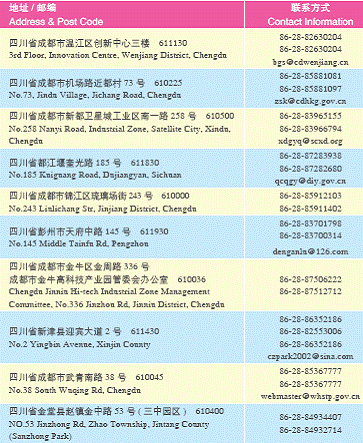
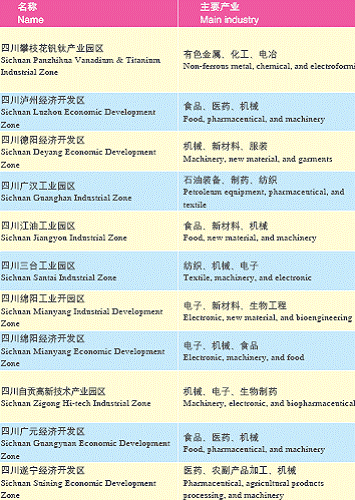
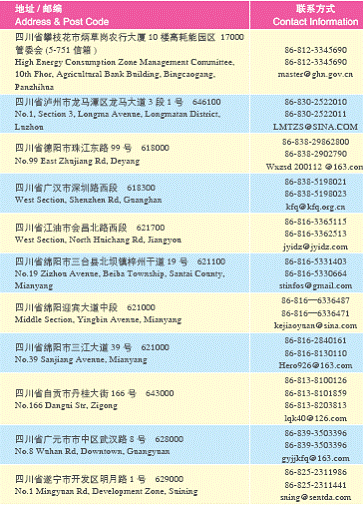



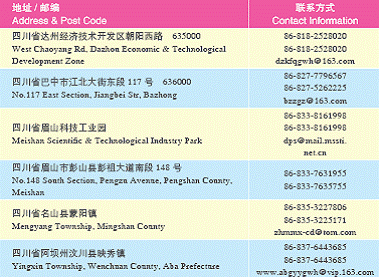
(iii) Relevant Institutions
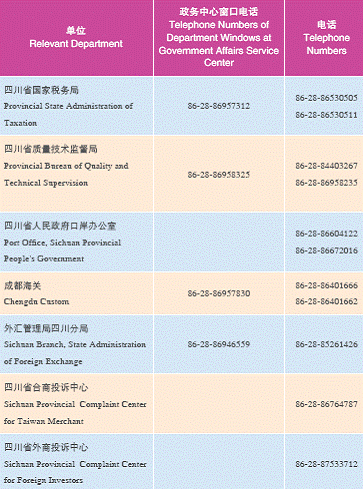
(iv) Relevant Websites
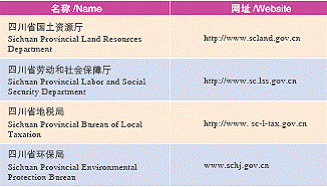
Appendix
Main Hotels in Sichuan

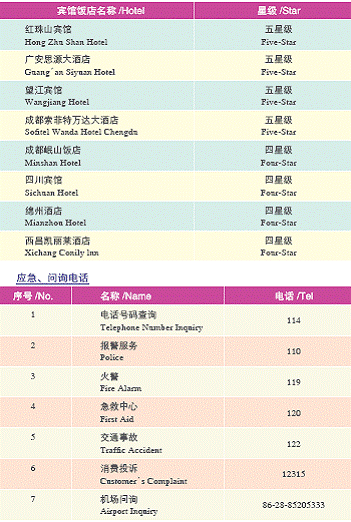
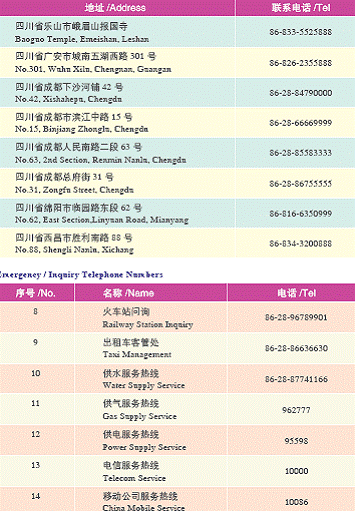
(Ministry of Commerce)